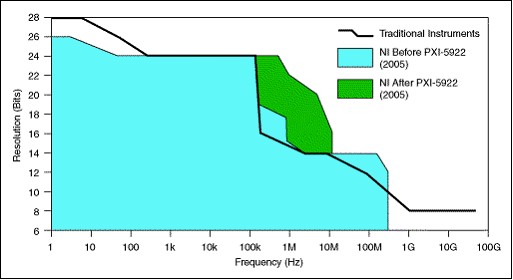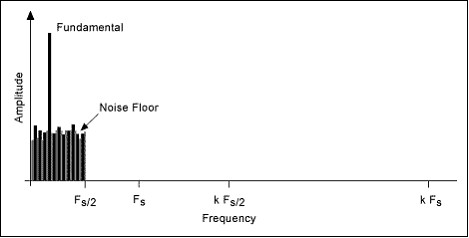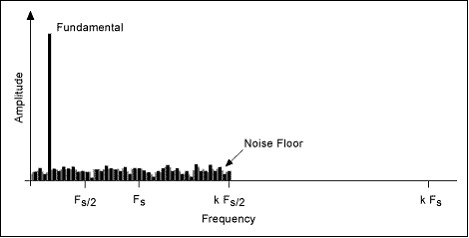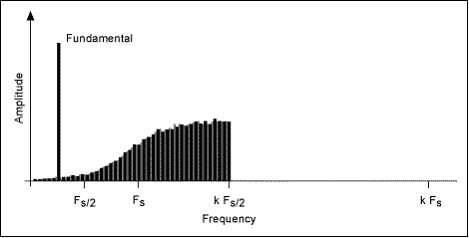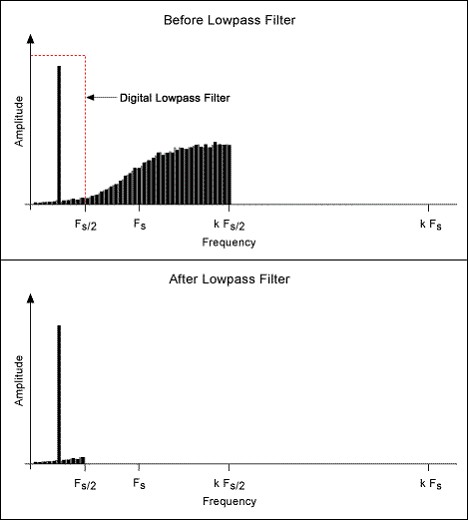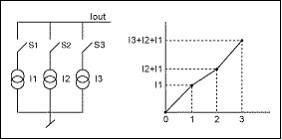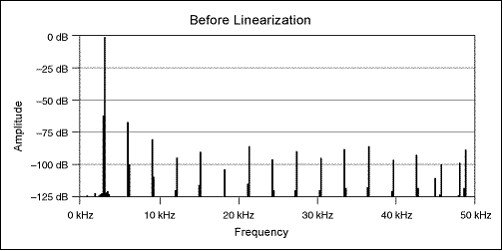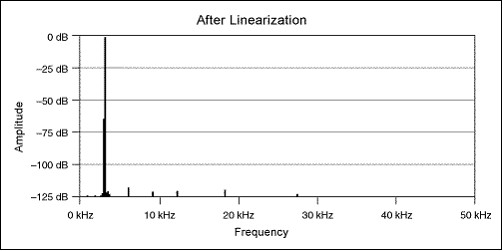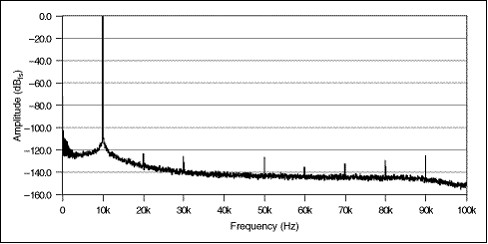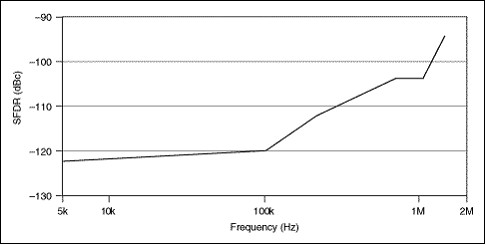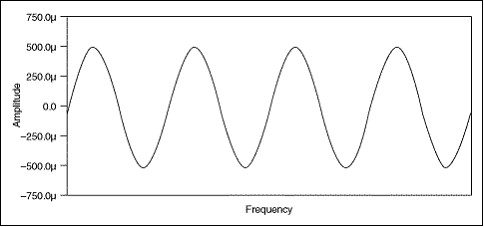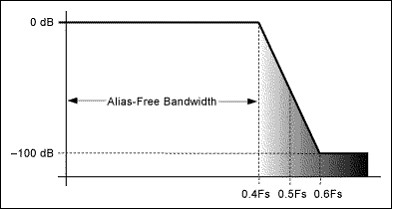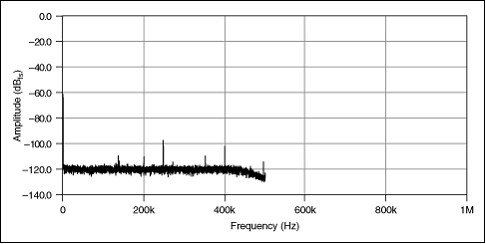Flex II ADC Technology: Flexible Resolution Technology Inside the PXI-5922 Oscilloscope
Overview
Single-bit delta-sigma analog-to-digital converters (ADCs) provide high resolution and high dynamic range for low-frequency applications. However, because of limited sampling speeds, single-bit delta-sigma ADCs are not available for applications involving dynamic signals greater than a few hundred kHz in frequency. Multibit delta-sigma ADCs can provide high dynamic range at high frequencies, provided that the ADC can be linearized to remove nonlinearities inherent to multibit delta-sigma ADCs. The PXI-5922 flexible resolution oscilloscope uses multibit delta-sigma ADCs together with patented linearization techniques to provide unprecedented resolution and dynamic range at higher sampling rates. This paper discusses the flexible resolution technology used in the PXI-5922 to make it the highest dynamic range oscilloscope on the market.
The PXI-5922 is the first universal instrument for dynamic measurements. Just as the digital multimeter (DMM) combined several DC measurements into one instrument, the PXI-5922 revolutionizes dynamic or AC measurements by providing the measurement capabilities of many instruments into one. With unmatched performance over a range of sampling rates up to 15 MS/s, this oscilloscope combined with powerful software such as NI LabVIEW, can be used to replace the measurement capabilities of many traditional instruments such as audio analyzers, spectrum analyzers, IF digitizers, DC and rms voltmeters, and frequency counters.
Contents
- Introduction
- Architecture of the PXI-5922
- Performance Examples of the PXI-5922
- Conclusion
- Patents
- Next steps
Introduction
The PXI-5922 is a flexible resolution oscilloscope that can be used to acquire data at different sampling rates to achieve variable resolutions depending on the need of the application. For example, at sampling rates up to 500 kS/s the PXI-5922 delivers 24-bit resolution. This same module, without any changes, can trade resolution for sampling speed and sample at 15 MS/s with 16-bit resolution. Figure 1 is a frequency-versus-resolution curve for this oscilloscope.
Figure 1. Frequency versus Resolution Curve of the PXI-5922 Flexible Resolution Oscilloscope
With its flexible resolution and high dynamic range, the PXI-5922 is the first universal instrument for dynamic measurements. Just as the digital multimeter (DMM) is used as a universal measurement device for DC measurements such as voltage, current, and resistance, the PXI-5922 revolutionizes AC measurements providing the measurement capabilities of many instruments into one. With unmatched performance over a range of sampling rates up to 15 MS/s, this oscilloscope combined with powerful software such as NI LabVIEW, can be used to replace the measurement capabilities of many traditional instruments such as audio analyzers, spectrum analyzers, IF oscilloscopes, DC and rms voltmeters, and frequency counters.
Many applications including audio, communications, and ultrasound demand extremely high dynamic performance. While traditional instrumentation has made incremental performance improvements, it has not been able to keep pace with the resolution and dynamic range requirements. On the other hand, the PXI-5922 introduces an unprecedented expansion in dynamic range and resolution as shown in Figure 2. This graph plots the frequency (speed at which the signal is digitized) versus the resolution (accuracy with which the signal is acquired) of traditional instrumentation versus National Instruments data acquisition and modular instrumentation devices.
Figure 2. Frequency versus Resolution Curve of Traditional Instruments versus NI Data Acquisition and Modular Instruments (before and after PXI-5922)
The PXI-5922, like other virtual instruments, exploits the powerful host computer to perform complex, algorithm-based linearization and calibration to eliminate temperature drift and nonlinearity errors. Although computers can be embedded in traditional instruments, the length of the development cycle for these instruments has historically precluded incorporation of the latest computing power. In contrast, as computer capability increases, virtual instrumentation can take immediate advantage of the increased horsepower.
The reason other PC-based oscilloscopes are unable to provide the resolution of the PXI-5922 is that most manufacturers rely on off-the-shelf ADCs from component vendors. Today there are no commercially available ADCs that can match the wide range performance of the PXI-5922. The unprecedented performance of the PXI-5922 is made possible with the next-generation flexible resolution ADC – the Flex II ADC, a portion of which is implemented on a fully custom analog ASIC designed by National Instruments.
Architecture of the PXI-5922
At the heart of the PXI-5922 oscilloscope is the next-generation flexible resolution converter, the Flex II ADC, which is built on a 27 GHz bipolar process. This section discusses the architecture of the Flex II ADC, which is an enhanced multibit delta-sigma converter.
Overview of Single-Bit Delta-Sigma ADCs
Figure 3 shows a block diagram of a simple single-bit delta-sigma ADC, which typically consists of a modulator and a digital signal processor (DSP).
Figure 3. Topology for Simple Single-Bit Delta-Sigma ADC
The single-bit modulator is comprised of a subtraction node, a loop filter, a 1-bit ADC, and a 1-bit DAC in a feedback loop. The ADC and DAC are oversampled at rates much higher than the desired sampling rate. The result of this oversampling is that the quantization noise is spread over a larger bandwidth, resulting in a lower noise floor as compared to other ADC architectures. This effect is illustrated in Figures 4 and 5.
Figure 4. In the FFT of a traditional (nonoversampled) ADC, quantization noise is distributed evenly up to Fs/2, where Fs is the sampling rate.
Figure 5. Effect of oversampling – the quantization noise is spread over a larger bandwidth up to kFs/2, where k is the oversampling factor. The result is a lower but spread-out noise floor.
The analog input signal is fed through a subtraction node to the analog loop filter, which has high gain at low frequencies and low gain at higher frequencies. This inherent characteristic makes it a lowpass filter. The quantization noise from the internal ADC is inversely proportional to the gain of the loop filter. As a result, the quantization noise gets highpass filtered in the feedback loop. This technique is referred to as ‘noise shaping’ and is illustrated in Figure 6.
Figure 6. Effect of noise shaping – the quantization noise is pushed into higher frequencies.
There is a change in the distribution of the quantization noise. The advantage of this kind of noise distribution is that most of the noise is concentrated in higher frequencies. This high-frequency noise can be easily eliminated in the digital domain by the application of a lowpass filter in the DSP. The signal is then decimated, which does not cause loss of information because the signal has been oversampled. Figure 7 illustrates the effect of the decimator.
Figure 7. Effects of the lowpass filter and decimator – elimination of the high-frequency noise and reduction of the sampling rate to Fs by decimation.
Flexible Resolution Flex II ADC - Fully Custom Analog ASIC
The Flex II ADC is an enhanced multibit delta-sigma ADC. The key enhancements over the simple single-bit delta-sigma ADC topology, which makes the outstanding performance possible, are as follows:
- Multibit ADC and DAC internal to the modulator
- Digital linearization and calibration
- Time-continuous loop filter
Figure 8 shows the block diagram of the Flex II ADC – an enhanced delta-sigma ADC.
Figure 8. Topology for the Enhanced Multibit Delta-Sigma ADC
Multibit ADC and DAC Internal to the Modulator
By eliminating most high-frequency noise, single-bit delta-sigma ADCs have high dynamic range. However, the major drawback of single-bit delta-sigma ADCs is that they operate at low frequencies and hence cannot be used in a variety of higher frequencies applications.
A solution to the frequency constraint problem of the single-bit delta-sigma ADC is the extension of the same basic principle to create a multibit delta-sigma ADC. Multibit delta-sigma ADCs, in theory, can achieve the same level of dynamic range as their single-bit counterparts, but at higher frequencies. However, multibit delta-sigma ADCs induce nonlinearities that have been a challenge to overcome until now.
The PXI-5922 is a 6-bit delta-sigma featuring a 6-bit ADC and DAC inside the modulator, each running at an oversampling rate of 120 MS/s. The induced nonlinearities caused by the multibit converter are reduced dramatically by the use of a patented linearization technique that results in the unprecedented dynamic range at higher frequencies.
Digital Linearization and Calibration
An elegant property of the feedback loop internal to the modulator is its ability to suppress errors. Unfortunately, this does not apply to errors in the feedback path of the loop. Hence conversion errors in the DAC are not attenuated and directly impact the quality of conversion from the modulator. The DAC degrades the total conversion quality in two ways:
- Analog noise in the output
- Nonlinearities
The noise performance is controlled by design on the ASIC, but the required linearity performance is more difficult to handle.
Consider the simple 2-bit DAC shown in Figure 9. The DAC converter consists of three current generators (I1-I3) controlled by three switches (S1-S3). The resulting output current Iout depends on the number of switches being closed. In case of different current values, the DAC transfer function becomes nonlinear, as shown in Figure 9. For ideal operation of the converter, the three current generators must be equal. Further, switches S1-S3 must operate simultaneously.
Figure 9. A 2-bit DAC and its corresponding transfer function are nonlinear if the current values are not the same or if the switching is not simultaneous.
The optimal implementation of the DAC is on an integrated circuit, which guarantees the best possible matching of current values and switching times. Unfortunately, it is not possible even on a chip to obtain the performance required.
The traditional approach to enhance matching on a chip is to adjust the circuit, for example, by laser wafer trimming. But packaging, aging, and temperature variations will degrade the matching. Moreover, trimming also significantly adds to the production cost of the chip.
To circumvent these issues, the PXI-5922 uses a different approach. The unavoidable matching errors are compensated digitally by the DSP. With the patented National Instruments flexible resolution technology, current and timing errors are derived in circuit during self-calibration, which is more optimal than matching at the wafer level.
NI flexible resolution technology is used to derive the error parameters. A pure analog sine wave signal is applied to the converter during self-calibration and the errors are extracted from the digital response of the converter in a complex algorithm executed on the host PC.
Figure 10. FFT Plot of a Pure 3 kHz Sine Wave Applied to the 6-Bit Delta-Sigma ADC before Linearization
Figure 11. FFT Plot of a Pure 3 kHz Sine Wave Applied to the 6-Bit Delta-Sigma ADC after Linearization
Time-Continuous Loop Filter
The loop filter internal to the Flex II ADC is time continuous (TC) as opposed to the standard switched capacitor filter used in the conventional implementation. The TC implementation is difficult to integrate on chip because it requires precision passives. However, the TC implementation is not sensitive to aliasing, so internal noise sources in the modulator do not alias and accumulate in the passband. As a result, the converter has less noise and more resolution. Another important benefit is that it is much easier to integrate the converter into the noisy environment of a oscilloscope, because high-frequency switching noise is rejected by the alias-free operation of the converter.
These enhancements are not possible to integrate on a chip, and component vendors that traditionally have been driving converter technology are excluded from offering similar performance.
It’s More Than Just the High-Resolution ADC
In addition to having a high-performance ADC, it is important to have a front end that does not cause a performance bottleneck. The PXI-5922 features a world-class analog front end that takes full advantage of the high-performance Flex II ADC and frees the oscilloscope to provide unparalleled performance.
The input amplifier has software-selectable input impedances of 50 Ω and 1 MΩ. The 50 Ω input provides correct BNC cable termination and is useful in applications where frequency response is important. The 1 MΩ input mode is useful with sources that cannot drive 50 Ω without saturation or linearity degradation.
The oscilloscope contains a programmable-gain instrumentation amplifier (PGIA) with selectable input ranges of 1 and 5 V.
Synchronization and Memory Core
The PXI-5922 is built on the Synchronization and Memory Core1 (SMC) architecture, so you can tightly synchronize PXI-5922 modules with other SMC-based modular instruments using T-Clock, an essential feature of SMC. This synchronization capability is critical when building mixed-signal test systems including signal generators, high-speed digital waveform generator/analyzers, and oscilloscopes. In addition, the SMC architecture provides up to 256 MB per channel of onboard memory on the PXI-5922 oscilloscope.
Performance Examples of the PXI-5922
The PXI-5922 is the highest dynamic range oscilloscope on the market. For most of the frequency-versus-resolution curve of this oscilloscope, there is no ADC or digitizing instrument with better performance. Likewise, there is no signal generator with better dynamic performance than the performance of the PXI-5922, which has two major implications. First, this oscilloscope can be used to characterize most DACs with frequencies within the bandwidth of the oscilloscope. Second, there is no source capable of generating a sine wave that is pure enough for characterization of the PXI-5922. This challenge was overcome by using innovative techniques to measure linearity, SFDR, SINAD, and so on. This section demonstrates the performance of the PXI-5922 by showing some of the typical performance plots.
Linearity and SFDR
With a single sine wave input, nonlinearity shows up in the frequency domain as harmonics. In order to test for harmonics, and hence linearity, of an ADC, a source with better linearity is needed. It is difficult to verify the linearity performance of PXI-5922, because there are no sources available with matching performance. Hence, we needed to use active lowpass filtering to attenuate the harmonics generated by a nonideal sine wave.
Figure 12 shows the spectral response of a full-scale 5 Vp sine wave that is acquired using the PXI-5922 with a sampling rate of 200 kS/s using the 5 V input range. The spectrum does not contain spurious components in excess of -120 dB, yielding spurious-free dynamic range (SFDR) of -120 dBc.
Note that the low-frequency noise in the spectrum originates from the source. At frequencies above 30 kHz, the noise of the source is attenuated by the filter. The remaining noise apparent in the spectrum is caused by the active filter and not by the source.
Figure 12. In this FFT of an acquisition of a very pure 10 kHz sine wave generated from a high-end generator and cleaned using signal conditioning, the SFDR of the PXI-5922 is as high as -120 dBc.
The technique described above works well for frequencies below 100 kHz. For verification of linearity at higher frequencies, it is not possible to use active filtering because it is difficult to find amplifiers with adequate linearity. For verification of the linearity of the PXI-5922 at higher frequencies, a different approach was used that involved using an arbitrary waveform generator for generating a nonideal sine wave. By attenuation of the fundamental in a linear notch filter, it was possible to accurately detect the harmonics from the generator. The harmonics were then iteratively removed from the generator by modification of the digital pattern sent to the generator.
Figure 13 shows the typical SFDR of the PXI-5922 as a function of frequency. Clean sine waves with amplitudes of 4 V were acquired using the PXI-5922 at sampling rate of 10 MS/s in the 5 V range. The harmonic components were below -100 dBc for frequencies all the way up to 1 MHz.
Figure 13. Typical SFDR of the PXI-5922 as a Function of Frequency
SINAD
As with linearity, it is not possible to find a source with noise performance that matches the low noise of the PXI-5922. The graph in Figure 14 was obtained by generating a 1 kHz sine wave with an amplitude of 5 V using an arbitrary waveform generator, and acquiring it using the PXI-5922 at a sampling rate of 100 kS/s in the 5 V range. The output was then attenuated in a low-impedance resistor divider by a factor 10,000. The attenuation decreased the inherent noise of the generator by 80 dB and revealed the true noise performance of PXI-5922. Note that despite the small amplitude of the signal (500 µV), the signal visually appears clean.
Figure 14. The low noise and high SINAD of the PXI-5922 makes it possible to acquire low-level signals. In this case, the amplitude of the 1 kHz sine wave was 500 µV and yet the signal appears very clean.
Another way of evaluating the noise performance is simply to acquire data with no signal applied to the input. Figure 15 shows the noise floor of an FFT with 10 MS/s sampling rate. The accumulated power in the spectrum from DC to 4 MHz is -95 dB relative to full scale. This is almost equivalent to 16 ENOB (effective number of bits). Also note the absence of spurious noise components in the system. The uneven distribution of noise in the frequency spectrum is caused by shaping of the quantization noise in the modulator as discussed earlier.
Figure 15. In this FFT of an acquisition using the PXI-5922 with no input signal, acquisition parameters were: sampling rate = 10 MS/s, input impedance = 50 Ω, input range = 5 V, number of averages = 10, and window = Hanning.
Antialias Protection
The PXI-5922 features an integrated antialias filter that provides an alias-free bandwidth of 0.4 times the sampling rate, as illustrated in the conceptual frequency response diagram in Figure 16.
Figure 16. PXI-5922 features integrated antialias protection with an alias-free bandwidth of 0.4 times Fs. This figure illustrates the conceptual frequency response of the antialias filter.
Figures 17 and 18 demonstrate the antialias protection of the oscilloscope. A full-scale 600 kHz sine wave was acquired at a sampling rate of 2 MS/s. As shown in Figure 17, the 600 kHz signal appears at the same frequency as expected. However, when the sampling rate is reduced to 1MS Topology/s, Nyquist theorem is violated, and the 600 kHz signal aliases back in the passband to 400 kHz, as illustrated in Figure 18. Because of the antialias filter, this aliased component is attenuated by 100 dB.
Figure 17. A full-scale 600 kHz sine wave is acquired at a sampling rate of 2 MS/s. The spurs and noise in the spectrum originate from the generator.
Figure 18. A full-scale 600 kHz sine wave is acquired at a rate of 1 MS/s with an alias-free bandwidth of 400 kHz. The 600 kHz signal aliases back 400 kHz after being attenuated by 100 dB.
Conclusion
The PXI-5922 uses patented techniques and a fully custom analog ASIC, the Flex II ADC, to provide the highest resolution and highest dynamic range of any oscilloscope on the market, up to 15 MS/s. Flexible resolution capability and high dynamic performance make the PXI-5922 a universal instrument for dynamic measurements. Combined with software, this universal instrument can be used to replace the measurement capabilities of many traditional instruments.
Patents
6,049,298
System and method for generating a linearity error correction device for an analog to digital converter
6,020,838
System and method for generating a sigma-delta correction circuit using matrix calculation of linearity error correction coefficients
5,955,979
System and method for compensating for glitch errors in a D/A converter
5,734,261
Input protection circuit which includes optocoupler protection during over-voltage conditions
Next steps
- Explore the PXI-5922 oscilloscope to see detailed specifications, choose accessories, and purchase your new oscilloscope
- Shop all NI oscilloscopes to choose the right one for your application
- Learn about the fundamentals of oscilloscope operation and performance in the Instrument Fundamentals series

